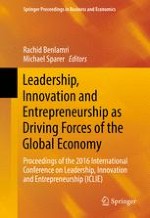This volume aims to outline the fundamental principles behind leadership, innovation and entrepreneurship and show how the interrelations between them promote business and trade practices in the global economy. Derived from the 2016 International Conference on Leadership, Innovation, and Entrepreneurship (ICLIE), this volume showcases original papers presenting current research, discoveries and innovations across disciplines such as business, social sciences, engineering, health sciences and medicine.
The pace of globalization is increasing at a rapid rate and is primarily driven by increasing volume of trade, accelerating pace of competition among nations, freer flows of capital and increased level of cooperation among trading partners. Leadership, innovation, and entrepreneurship are key driving forces in enhancing this phenomenon and are among the major catalysts for contemporary businesses trading in the global economy. This conference and the enclosed papers provides a platform in which to disseminate and exchange ideas to promote a better understanding of current issues and solutions to challenges in the globalized economy in relation to the fields of entrepreneurship, business and economics, technology management, and Islamic finance and management. Thus, the theories, research, innovations, methods and practices presented in this book will be of use to researchers, practitioners, student and policy makers across the globe.
